Yad Mordechai/Ayalon Institute
Day Twelve - Friday July 14th -  - Yom
Shee-she
- Yom
Shee-she
This morning I was faced with making the decision to go or not go to Yad Mordechai, to Ayalon Institute, to within firing range of Gaza. I really toiled over this decision, even up to the moment that I made the decision. Amy Beth didn’t ask me anything about it, which I appreciated. I told her as we got up, to get ready, because they may decide to go somewhere else and we should be ready to go. I was also hoping that Gadi and the Rabbi would decide not to go to Yad Mordechai, only a few miles north of Gaza.
That decision was not made by them. We went downstairs, where I saw the Rabbi and he said “we are going.” Gadi also indicated that Gaza has been relatively calm over the past few days. They reiterated that we wouldn’t go into an area where they thought that there would be
trouble.
I asked Gadi, “are we in range of the rockets?” He answered, “yes.” When you go near Gaza, you are in range. Regardless of any assurances from Gadi and the Rabbi, I knew that going to Yad Mordechai, would put us in a higher level of danger. For goodness sakes, we were in Tzefat the morning of the afternoon where Katyusha rockets killed one lady, and rockets fell on Haifa, the day we drove through. They didn’t predict that either. So, was I afraid? You bet. I was afraid of the danger, but I found myself “yearning” to go. The logic told me not to go, but the emotion told me to go.
The final decision, to go or not go, was still in my “court.”
I decided that we should go.
I told Amy Beth as we were eating, choking back tears for me, as this was emotional, I noticed that Amy Beth was happy and proud of my decision. After all of the consternation, and vacillation over this decision, going between the logic of the facts, and severity of the recent developments, and the emotion of the points that Amy Beth brought up, which I fully considered – although she didn’t think I heard her, I decided to go.
Thoughts: It was an emotional decision, and a very difficult one for me. But, what “mark” did I want to put on this trip? What was I going to remember about this trip, that the events triggered by the Terrorists would change my agenda, and make me stay home on one of my “precious few” days in Israel (and “give in” to the fear), or would I make a bolder decision and go where there was not imminent danger and see, one more day in Israel? I knew this was a significant moment on my trip. On a lighter note, I wanted a “good story” to tell!
It was more of symbolic thing of going, versus staying back, because in actuality, it is such a small percentage chance of something happening close to you, it wasn’t like stay home and live, or go and die. Still, it was a very difficult decision to make.
On to Yad Mordechai!
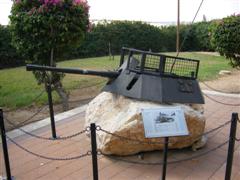 We have 10 of us going to Yad Mordechai, so I named the group,
"The Gaza Minyan", in light of my morning’s thoughts. They are: The Rabbi and Ruby, Me and Amy Beth, Frances and Larry, Mark, Angel, Sam, Daniel. We have 10 of us going to Yad Mordechai, so I named the group,
"The Gaza Minyan", in light of my morning’s thoughts. They are: The Rabbi and Ruby, Me and Amy Beth, Frances and Larry, Mark, Angel, Sam, Daniel.
All of the road signs have Hebrew, Arabic, and English on them. Some have only Hebrew and English. It would be easy to get around in Israel with your own car, they drive on the same sides of the road as they do in America.
Another observation – this one totally out of the blue: Every toilet in Israel has two buttons to flush, one small and one big. I have tried them both, they both seem to use a tremendous amount of water. One is supposed to be a “half flush,” but I can’t tell that that’s the case. Either way, I never knew which one to use!
We passed Yaveneh, where Rabbi Gamliel is buried. I took a few shots of Ashdod as we passed it. Ashdod is the 4th largest city in Israel. We also passed At Alom, which means “unto here” which is where, during the war of Independence, the Egyptian advances were stopped. If they weren’t stopped there, within a day or two, they would have been into Tel Aviv. Nitzanim is a kibbutz on the eastern side of rt. 4, which is where they were temporarily housing some of the people displaced by the evacuation of the Gaza strip.
We also passed signs for a nuclear labratory. There are no nuclear
reactors in Israel, but there is this research lab.
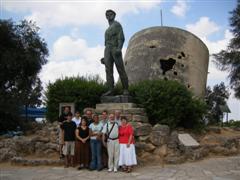 Yad Mordechai is a kibbutz where a significant battle took place (in May 1948) between the Israeli fighters (including some Palmach and some kibbutznicks – I believe numbering less than 200 people) and the Egyptians numbering some 2000 soldiers. They repelled the Egyptians from the hills of Yad Mordechai and held them off until they literally ran out of ammunition and had to give up their position. The delay caused by their valiant stance was enough to assist in getting into position to defeat them at At
Alom. Yad Mordechai is a kibbutz where a significant battle took place (in May 1948) between the Israeli fighters (including some Palmach and some kibbutznicks – I believe numbering less than 200 people) and the Egyptians numbering some 2000 soldiers. They repelled the Egyptians from the hills of Yad Mordechai and held them off until they literally ran out of ammunition and had to give up their position. The delay caused by their valiant stance was enough to assist in getting into position to defeat them at At
Alom.
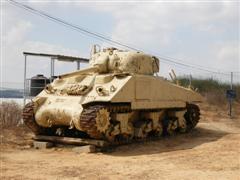 I
took a picture of an Egyptian tank that was stopped in it’s tracks and was left there ever since. I
took a picture of an Egyptian tank that was stopped in it’s tracks and was left there ever since.
Yad Mordechai was named after the brave leader of the resistance Hashomer Ha’zaier of the Warsaw ghetto uprising, Mordechai Anilewicz. After the Yad Mordechai kibbutz burned (as a result of having to vacate due to the lack of ammunition), it was rebuilt in November of 1948.
I spoke, via phone, to Tali Wilf who said, “what did you bring with you?” referring to the escalating war in Lebanon. I told her it followed us! Hopefully, it will not follow
us to Tel Aviv.
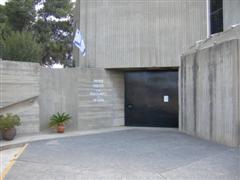 The museum at Yad Mordechai was absolutely astounding in it’s architecture. The curator there told me that they had won many awards for the design. The tour in the museum takes you from the Warsaw ghetto, up through the Holocaust, and then finally to the settlement of Yad Mordechai, and 11 other kibbutzim that were established the night of Yom Kippur
1946. Once an area was established the British were not allowed to take it down, so these kibbutzim were all established overnight, in one night! Those 11 kibbutzim are now flourishing paradises! The museum at Yad Mordechai was absolutely astounding in it’s architecture. The curator there told me that they had won many awards for the design. The tour in the museum takes you from the Warsaw ghetto, up through the Holocaust, and then finally to the settlement of Yad Mordechai, and 11 other kibbutzim that were established the night of Yom Kippur
1946. Once an area was established the British were not allowed to take it down, so these kibbutzim were all established overnight, in one night! Those 11 kibbutzim are now flourishing paradises!
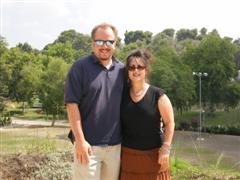 The first thing that was established was a 6” water pipeline between the kibbutzim. They even had to run the line through some enemy territory, but they were able to accomplish it. During the war of Independence, many of these kibbutzim were attacked. Some were overtaken, some were defended. One in particular Kfar Del Ron was completely destroyed by the Egyptians, but then was recaptured in the 1967 war and rebuilt. The first thing that was established was a 6” water pipeline between the kibbutzim. They even had to run the line through some enemy territory, but they were able to accomplish it. During the war of Independence, many of these kibbutzim were attacked. Some were overtaken, some were defended. One in particular Kfar Del Ron was completely destroyed by the Egyptians, but then was recaptured in the 1967 war and rebuilt.
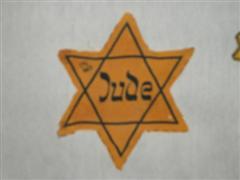 As we toured the museum, I learned about the Judenrat, the Jews that were given charge by the Germans, to try to get the Jews to believe that there were no death camps, that the rumors were not true, and that they should go willingly as they were taken. “Rat” is an appropriate term for them. As we toured the museum, I learned about the Judenrat, the Jews that were given charge by the Germans, to try to get the Jews to believe that there were no death camps, that the rumors were not true, and that they should go willingly as they were taken. “Rat” is an appropriate term for them.
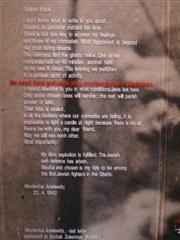 I took a picture of the last letter from Mordechai Anilewicz to Yitchak Zuckerman who was also a leader in the uprising (which broke out on the eve of Passover 1943) and who knew the lady Havka (the survivor) that we spoke to. The letter was written in the dire moments of the uprising, but he was proud to have led the uprising and of what they had accomplished against the Germans. I took a picture of the last letter from Mordechai Anilewicz to Yitchak Zuckerman who was also a leader in the uprising (which broke out on the eve of Passover 1943) and who knew the lady Havka (the survivor) that we spoke to. The letter was written in the dire moments of the uprising, but he was proud to have led the uprising and of what they had accomplished against the Germans.
We then traveled to Rehovot where the Ayalon Institute bullet factory is located.
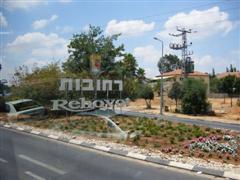 Observation: Everywhere you go, you see this image of the Lebavicher Rebbe Menachem Schneersohn plastered to walls, street signs, doorways, mailboxes, arches, and restaurants. Many of the Chabadnicks (especially in Jerusalem) still believe that he is Moshiach, I don’t get that either. Yossel and I had a long discussion on this several years ago, and he said it was (and still is) hard for some of the people to let go of the idea, although they should, because it is obvious that he is not who they think he is. Observation: Everywhere you go, you see this image of the Lebavicher Rebbe Menachem Schneersohn plastered to walls, street signs, doorways, mailboxes, arches, and restaurants. Many of the Chabadnicks (especially in Jerusalem) still believe that he is Moshiach, I don’t get that either. Yossel and I had a long discussion on this several years ago, and he said it was (and still is) hard for some of the people to let go of the idea, although they should, because it is obvious that he is not who they think he is.
Observation: All of my dreams have been Israel related, in Hebrew. I don’t specifically recall any dreams as I have been sleeping great in Israel, but I know that my slumber hasn’t been occupied with thoughts of computers!
 We arrived at the Ayalon institute in Rehovot where we saw the underground bullet factory where they manufactured 14,000 bullets per day. A total of 2.25 million bullets where manufactured here. However, given the astounding output in all the time that the factory was in production, there was only one accident, where a worker lost a finger. We arrived at the Ayalon institute in Rehovot where we saw the underground bullet factory where they manufactured 14,000 bullets per day. A total of 2.25 million bullets where manufactured here. However, given the astounding output in all the time that the factory was in production, there was only one accident, where a worker lost a finger.
The factory is the size of a tennis court and was completely built in 21 days. The hole for the factory was completely dug out in just 10 days! The factory is 25 feet below, protected by 2 feet of reinforced concrete.
 The entrance to the factory was hidden by both a bakery and a laundry facility. Only the kibbutznicks who worked in the factory were made aware of it’s existence. The kibbutznicks who didn’t know about it were called (among the workers) “giraffes.” Since a giraffe’s neck is so long and it cannot see what is at its own feet, so too, the kibbutznicks would be in the bakery and not even know about the bullet factory below their feet. This helped to keep the secrecy of the factory. They would scrape the metal off of their shoes before leaving the factory at night, they would sit in a tanning bed below ground for 10 minutes each day to tan their skins as a kibbutznick should be tanned since they are out in the field all day working. The entrance to the factory was hidden by both a bakery and a laundry facility. Only the kibbutznicks who worked in the factory were made aware of it’s existence. The kibbutznicks who didn’t know about it were called (among the workers) “giraffes.” Since a giraffe’s neck is so long and it cannot see what is at its own feet, so too, the kibbutznicks would be in the bakery and not even know about the bullet factory below their feet. This helped to keep the secrecy of the factory. They would scrape the metal off of their shoes before leaving the factory at night, they would sit in a tanning bed below ground for 10 minutes each day to tan their skins as a kibbutznick should be tanned since they are out in the field all day working.
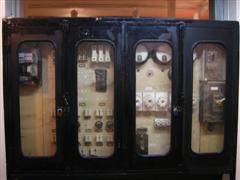 They stole electric power from the power company as the meter information was hidden by those Jews who worked at the power company. After all, it’s hard to hide records of all
of that consumed electricity. The workers would sneak in the back entrance to the laundry room and would enter the factory in 40 seconds using narrow ladder hidden under a washing machine that was basically there to “make noise!” Again, to hide the factory. They stole electric power from the power company as the meter information was hidden by those Jews who worked at the power company. After all, it’s hard to hide records of all
of that consumed electricity. The workers would sneak in the back entrance to the laundry room and would enter the factory in 40 seconds using narrow ladder hidden under a washing machine that was basically there to “make noise!” Again, to hide the factory.
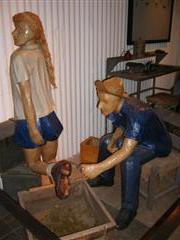 They had a series of light signals that would alert workers if a giraffe was up above in the bakery or the laundry room. Also, they had a light that warned them of British officials who might be present on the kibbutz. In this case the factory would completely shut down and wait until the British were completely gone. They had a series of light signals that would alert workers if a giraffe was up above in the bakery or the laundry room. Also, they had a light that warned them of British officials who might be present on the kibbutz. In this case the factory would completely shut down and wait until the British were completely gone.
There was another flash of signals that would alert the workers to come up as there was an emergency.
There is a story that was shared where one of the laundry workers, a giraffe, who accidentally walked in on the workers as they were coming out of the factory. She had to be made aware of the entirety of the importance of the secrecy of the factory. After seeing it, she volunteered to work down there. It was not an easy place to work.
We were then taken back to Tel Aviv where we stopped at an art show several blocks from the Dan Panorama hotel. We ate lunch and then enjoyed the shopping. There were tons of artists exhibiting some beautifully colored wares.
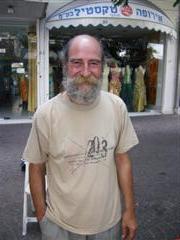 We bought two paintings from Jose, who looked like Ernest Hemingway! He didn’t speak English, only Spanish. We negotiated by calculator! We bought two paintings from Jose, who looked like Ernest Hemingway! He didn’t speak English, only Spanish. We negotiated by calculator!
We are very happy with what we bought. We will put these paintings on our kitchen wall. We got one blue and one orange, I was really happy with the colors until Amy Beth pointed out that these were UVA colors. Oh well, I guess I’ll be eating in the family room from now on!
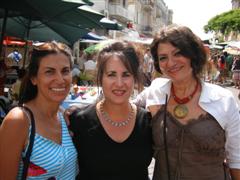 We bumped into Mali Davis (and her nephew) at about 3:15 pm completely out of the blue! She was so excited to see us, and we were excited to see her. We spoke for about 20 minutes, and then we had to get running as we planned to meet with Ilan and Tali Wilf at 4pm. We bumped into Mali Davis (and her nephew) at about 3:15 pm completely out of the blue! She was so excited to see us, and we were excited to see her. We spoke for about 20 minutes, and then we had to get running as we planned to meet with Ilan and Tali Wilf at 4pm.
I heard on the news that
Sderot, a town near Gaza (about 5 miles from Yad Mordechai), was hit by a Quasam rocket. The security counsel is now convening to determine the world reaction to all of this. I hope it understands of the Israeli plight. It’s Friday evening and Katyusha rockets are flying into Nahariya just north of Haifa.
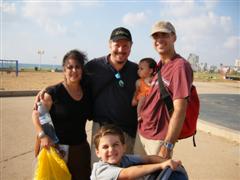 We spent an hour or so overlooking the Mediterranean Sea with Ilan and Tali Wilf. They look great and are getting settled into the move back to Israel. Ilan and I took a walk down the boardwalk. It was the first time that I
was able to really relax all week, and it was only about a half of an hour. I slid down the slides with Neev and Ilan, and we said goodbye, always too short of a get
together. Our time in Israel is so precious. We spent an hour or so overlooking the Mediterranean Sea with Ilan and Tali Wilf. They look great and are getting settled into the move back to Israel. Ilan and I took a walk down the boardwalk. It was the first time that I
was able to really relax all week, and it was only about a half of an hour. I slid down the slides with Neev and Ilan, and we said goodbye, always too short of a get
together. Our time in Israel is so precious.
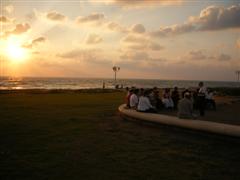 The
group met over in front of the Mediterranean Sea for Friday night prayers. It was an absolutely beautiful sunset, the prettiest that I’ve seen here, over the Mediterranean. A great place to hold services. The
group met over in front of the Mediterranean Sea for Friday night prayers. It was an absolutely beautiful sunset, the prettiest that I’ve seen here, over the Mediterranean. A great place to hold services.
We had dinner at the hotel, which was yet another lavish (and gluttonous) dinner. I’m
quite certain that at this point, I’ve gained some weight!
[ Back ] [ Up ] [ Next ]
|